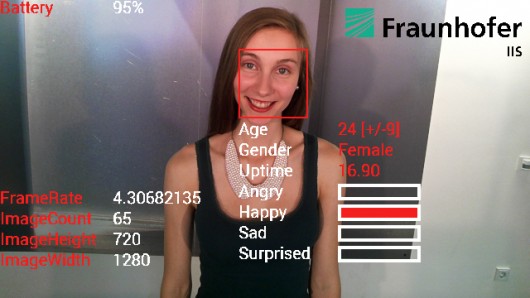
Facial recognition technology developed at the Fraunhofer Institute can detect human emotion (Photo: Fraunhofer Institute)
Over a number of years, researchers at Germany's Fraunhofer Institute have developed software to measure human emotion through face detection and analysis. Dubbed SHORE (Sophisticated High-speed Object Recognition), the technology has the potential to aid communication for those with disabilities. Now the team has repurposed the software as an app for Google Glass, with a view to bringing its emotion-detecting technology to the world.
Facial recognition has been a hot-button issue where Google Glass is concerned. The idea of strangers identifying and streaming your online details in the time it takes to wander past them in the street would be a little unsettling for most. Fraunhofer is quick to emphasize, however, its software can't determine a person's identity, it purely analyzes their emotions in real-time, with none of the information ever leaving the device. All the calculations are carried out in real-time by the CPU integrated in the eyewear.
The SHORE technology is based on recognizing structure-based features, learning algorithms and was "trained" through the use of a database containing more than 10,000 annotated faces. It gauges emotions, such as anger, happiness, sadness and surprise, and displays this information on screen. It is also capable of estimating gender and age, a feature Fraunhofer says could lead to applications in interactive gaming and market research.
Looking past its potential to engender a new breed of smart eyewear solutions, the app could have very real applications for those with communicative disabilities, such as autism. Emotions that the wearer is unable to interpret could be processed by the app, with the data then superimposed in their field of vision to paint a more complete picture of the social interaction. Another use for SHORE could be as a tool for the visually impaired, with missing information relayed through audio feedback.
Through participation in the Google Glass Explorer Program, the Fraunhofer researchers have tested the smart eyewear, though they are yet to detail a launch date for the app. In any case, it may yet find another vehicle, with the team claiming the technology has a high degree of optimization and can be adapted to just about any platform or operating system.
You can see a demonstration of the SHORE technology in the video below.
Source: Fraunhofer
Copyright © gizmag 2003 - 2014 To subscribe or visit go to: http://www.gizmag.com
http://www.gizmag.com/fraunhofer-shore-google-glass-human-emotion/33568/